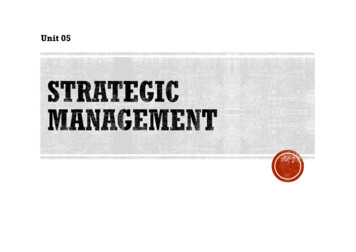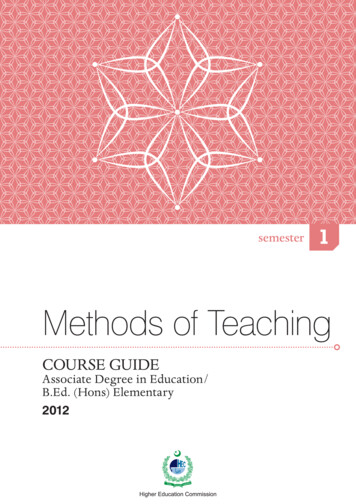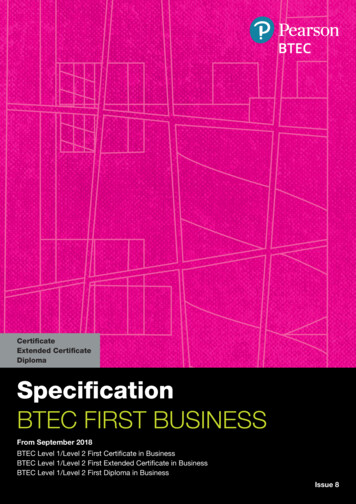
Transcription
Unit 05
LEARNI NG OUTLI NEFOLLOW THIS LEARNING OUTLINE AS YOU READ AND STUDY THISCHAPTER.The Importance of Strategic Management Explain why strategic management is important. Discuss what studies of the effectiveness of strategicmanagement have shown.The Strategic Management Process List six steps in the strategic management process. Describe what managers do when they do external andinternal analyses. Explain the role of resources, capabilities, and corecompetencies in the internal analysis.8–2
L E A R N I N G O U T L I N E (CONT’D)FOLLOW THIS LEARNING OUTLINE AS YOU READ AND STUDY THISCHAPTER.Types of Organizational Strategies Explain the three growth strategies. Discuss the BCG matrix and how it’s used. Define SBUs and business-level strategies. Describe the role of competitive advantage in business-level strategies. Explain Porter’s five forces model. Describe three generic competitive strategies.8–3
The purpose of the enterpriseOur guiding aspirations What is ourwinning aspiration?Where willwe play? Where we will compete: geographies,product categories, consumersegments, channels, value systemsThe unique right to win:How will Our valuewe play?proposition Our competitiveadvantageThe set of capabilities required toWhat capabilitieswin:must be in place? Our reinforcing activities Our specific configurationThe support systems: Systems, structures and measuresrequired to support our choicesWhat managementsystems6–4are required?
§ The set of managerial decisionsand actions that determinesthe long-run performanceof an organization.8–5
1.It results in higher organizationalperformance.2.It requires that managers examine and adaptto business environment changes.3.It coordinates diverse organizational units,helping them focus on organizational goals.4.It is very much involved in the managerialdecision-making process.8–6
THE STRATEGIC MANAGEMENT PROCESSExhibit 8.18–7
§ Step 1: Identifying the organization’s currentmission, objectives, and strategies§ Mission: the firm’s reason for being§ The scope of its products and services§ Goals: the foundation for further planning§ Measurable performance targets§ Step 2: Conducting an external analysis§ The environmental scanning of specific and generalenvironments§ Focuses on identifying opportunities and threats8–8
§ Step 3: Conducting an internal analysis§ Assessing organizational resources, capabilities, activities,and culture:§ Strengths (core competencies) create value for the customer andstrengthen the competitive position of the firm.§ Weaknesses (things done poorly or not at all) can place the firmat a competitive disadvantage.§ Steps 2 and 3 combined are called a SWOTanalysis. (Strengths, Weaknesses, Opportunities,and Threats)
PriceLow CostU.S. first-class postageMotel-6, Red Roof InnsQualityHigh-performance design Sony TVor high quality Consistent Lexus, CadillacqualityPepsi, Kodak, MotorolaTimeRapid deliveryOn-time deliveryExpress Mail, Fedex,One-hour photo, UPSFlexibilityVarietyVolumeBurger KingSupermarketsServiceSuperior enceBanks, ATMs8–10
IDENTIFYING THE ORGANIZATION’S OPPORTUNITIESExhibit 8.38–11
§ Step 4: Formulating strategies§ Develop and evaluate strategic alternatives§ Select appropriate strategies for all levels in the organizationthat provide relative advantage over competitors§ Match organizational strengths to environmentalopportunities§ Correct weaknesses and guard against threats8–12
§ Step 5: Implementing strategies§ Implementation: effectively fitting organizational structureand activities to the environment§ The environment dictates the chosen strategy; effectivestrategy implementation requires an organizational structurematched to its requirements.§ Step 6: Evaluating Results§ How effective have strategies been?§ What adjustments, if any, are necessary?
THE STRATEGIC MANAGEMENT PROCESSExhibit 8.18–14
LEVELS OF ORGANIZATIONAL STRATEGYExhibit 8.48–15
6–16What are possible ways acompany may expand itsbusiness?
Corporate strategy deals with three key issuefacing the corporation as a whole:§ The firm’s overall orientation towardgrowth, stability or retrenchment (directionalstrategy)§ The industries or markets (Portfoliostrategy)§ The manner in which managementcoordinates activities and transfersresources and cultivates capabilities amongproduct lines and business units
statusValuablestrengthsCorporateGrowth strategiesRetrenchment nment statusCriticalenvironmentalthreats
§ Growth Strategy§ Seeking to increase the organization’s business by expansioninto new products and markets.§ Types of Growth Strategies§ Concentration§ Vertical integration§ Horizontal integration§ Diversification8–19
§ Concentration§ Focusing on a primary line of business and increasing thenumber of products offered or markets served.§ Vertical Integration§ Backward vertical integration: attempting to gain control ofinputs (become a self-supplier).§ Forward vertical integration: attempting to gain control ofoutput through control of the distribution channel and/orprovide customer service activities (eliminatingintermediaries).
§ Horizontal Integration§ Combining operations with another competitor in the sameindustry to increase competitive strengths and lowercompetition among industry rivals.§ Related Diversification§ Expanding by merging with or acquiring firms in different,but related industries that are “strategic fits”.§ Unrelated Diversification§ Growing by merging with or acquiring firms in unrelatedindustries where higher financial returns are possible.8–21
§ Stability Strategy§ A strategy that seeks to maintain the status quo to deal withthe uncertainty of a dynamic environment, when the industryis experiencing slow- or no-growth conditions, or if theowners of the firm elect not to grow for personal reasons.
§ Renewal Strategies§ Developing strategies to counter organization weaknessesthat are leading to performance declines.§ Retrenchment: focusing of eliminating non-critical weaknessesand restoring strengths to overcome current performanceproblems.§ Turnaround: addressing critical long-term performanceproblems through the use of strong cost elimination measuresand large-scale organizational restructuring solutions.8–23
THE BCG MATRIXExhibit 8.58–24
§ Business-Level Strategy§ A strategy that seeks to determine how an organizationshould compete in each of its SBUs (strategic business units).8–25
6–26
§ Competitive Advantage§ An organization’s distinctive competitive edge that issourced and sustained in its core competencies.§ Quality as a Competitive Advantage§ Differentiates the firm from its competitors.§ Can create a sustainable competitive advantage.§ Represents the company’s focus on quality management toachieve continuous improvement and meet customers’demand for quality.8–27
§ Sustainable Competitive Advantage§ Continuing over time to effectively exploit resources anddevelop core competencies that enable an organization to keepits edge over its industry competitors.Copyright 2005 Prentice Hall, Inc.All rights reserved.8–28
FORCES IN THE INDUSTRYANALYSISExhibit 8.68–29
§ Threat of New Entrants§ The ease or difficulty with which new competitors can enteran industry.§ Threat of Substitutes§ The extent to which switching costs and brand loyalty affectthe likelihood of customers adopting substitutes productsand services.§ Bargaining Power of Buyers§ The degree to which buyers have the market strength to holdsway over and influence competitors in an industry.8–30
§ Bargaining Power of Suppliers§ The relative number of buyers to suppliers and threats fromsubstitutes and new entrants affect the buyer-supplierrelationship.§ Current Rivalry§ Intensity among rivals increases when industry growth ratesslow, demand falls, and product prices descend.8–31
§ Cost Leadership Strategy§ Seeking to attain the lowest total overall costs relative toother industry competitors.§ Differentiation Strategy§ Attempting to create a unique and distinctive product orservice for which customers will pay a premium.§ Focus Strategy§ Using a cost or differentiation advantage to exploit aparticular market segment rather a larger market.8–32
§ Cost Leadership§ On-line activities: bidding, order processing, inventory control,recruitment and hiring§ Differentiation§ Internet-based knowledge systems, on-line ordering andcustomer support§ Focus§ Chat rooms and discussion boards, targeted web sites8–33
§ Giving the customers what they want.§ Communicating effectively with them.§ Providing employees with customer service training.Copyright 2005 Prentice Hall, Inc.All rights reserved.8–34
§ Possible Events§ Radical breakthroughs in products.§ Application of existing technology to new uses.§ Strategic Decisions about Innovation§ Basic research§ Product development§ Process innovation§ First Mover§ An organization that brings a product innovation to market oruse a new process innovationsCopyright 2005 Prentice Hall, Inc.All rights reserved.8–35
FIRST-MOVER ADVANTAGES–DISADVANTAGES§ Advantages§ Reputation for beinginnovative and industryleader§ Disadvantages§ Uncertainty over exactdirection technology andmarket will go§ Cost and learning§ Risk of competitors imitating§ Control over scarce§ Financial and strategic risksbenefitsresources and keepingcompetitors from havingaccess to theminnovations§ High development costs§ Opportunity to beginbuilding customerrelationships andcustomer loyaltyExhibit 8.88–36
It results in higher organizational performance. 2. It requires that managers examine and adapt to business environment changes. 3. It coordinates diverse










